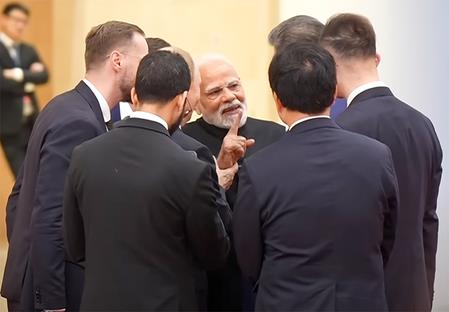Meeting Between PM Modi, Putin And Xi Reflected Rare Display Of Unity: Report
The handshakes, hugs, and a rare display of camaraderie, moments where PM Modi physically drew the other two leaders together, stole the spotlight at the summit meeting of leaders.
"The recent trilateral gathering of Putin, Xi, and Modi at the 2025 SCO Summit in Tianjin represents much more than diplomatic choreography or photo opportunities; it is a moment of consequence that throws the United States' twenty-five-year project of rapprochement and deepening partnership with India into sharp relief," a report in 'One World Outlook' detailed.
"While US policy enters a phase of unpredictability and economic confrontation, the visible warmth and symbolism displayed among the leaders of Russia, China, and India underscore the risks of strategic complacency in Washington and the historic value of treating India as an unshakeable partner-not a bargaining chip," it added
The report emphasised that Modi's visit to China marked his first in seven years -- a period defined by longstanding Sino-Indian tensions, including the Ladakh border dispute, mutual restrictions on investment and technology exchange. The visible warmth between the leaders conveyed a strong message that, in an era of US protectionism and punitive tariffs, especially targetting India, the Eurasian powers are indicating their intent to set their own rules and alliances.
According to the report, in contrast to some Western interpretations, India's participation at the summit is neither a shift eastward nor any alignment with Russia or China's agendas.
India continues to assert its strategic autonomy, which was clearly reflected in its assertive statements on terrorism at the summit, serving as a subtle rebuke to Pakistan in the latter's presence.
The report stated that as India garners global backing for its stance on Kashmir and beyond, its decades-old non-alignment policy remains active, driven by self-interest and the aim to maximise leverage in the evolving contemporary world landscape.
"Recent years saw breakthrough agreements on cybersecurity, advanced communications (COMCASA), and export controls, as well as new joint initiatives around semiconductor supply chains and clean energy. India's demographic, economic, and technological potential is undeniable: with a population projected to surpass China's, a youthful workforce, and ambitions to be the world's next manufacturing hub, India is one of the few countries with both the scale and credibility to anchor a democratic order in the Indo-Pacific," the report noted.
"To treat India as a secondary power - or worse, to penalise it for hedging its bets amidst a more aggressive US-China rivalry - would be a costly strategic mistake," it further stressed.

Legal Disclaimer:
MENAFN provides the
information “as is” without warranty of any kind. We do not accept
any responsibility or liability for the accuracy, content, images,
videos, licenses, completeness, legality, or reliability of the information
contained in this article. If you have any complaints or copyright
issues related to this article, kindly contact the provider above.
Most popular stories
Market Research

- Falconx Launches First Ethereum Staking Rate Forwards (Fras) Referencing Treehouse's TESR
- Ethereum Based Meme Coin Pepeto Presale Past $6.7 Million As Exchange Demo Launches
- Solstice Announces Strategic Collaboration With Chainlink And Leading Custody And Venture Firms To Enhance Ecosystem Ahead Of USX Stablecoin Launch
- Zebu Live 2025 Welcomes Coinbase, Solana, And Other Leaders Together For UK's Biggest Web3 Summit
- Falcon Finance Unveils $FF Governance Token In Updated Whitepaper
- Noveba Brings Apple Pay To Customers






















Comments
No comment